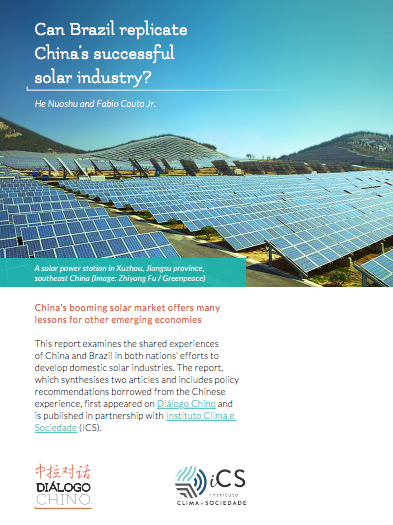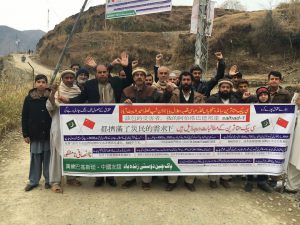Read in Chinese 中文版本
- This is the second in a special two-part series examining Brazil’s solar sector
- The first part looks the history and policy choices that have left Brazil with no significant national solar industry
- Download this special report as a pdf by clicking here
China’s solar power sector started to boom in recent years – not only in manufacturing, but also in domestic installations – thanks to strong government backing and a favourable policy environment. The rate of growth has stunned the world, as has the falling cost, beating expectations even of industry insiders.
By the end of 2015, China had 43 gigawatts of installed solar power, and had overtaken Germany, another country that saw strong industrial policy supporting solar power, as the global leader. Last year, eight of the top-10 solar PV module manufacturers were Chinese.
But the history is a longer one. The Chinese government has supported research and development (R&D) on solar PV since the 1950s, mainly for its uses in space. A PV module manufacturing industry developed during the 1990s. It remained small and of variable quality but became a crucial part of providing energy access to remote communities. The Brightness Programme, launched in 1996, was the first national policy to bring electricity access to off-grid areas of western China using renewable energy.
In the mid-2000s, China’s solar PV policy shifted to boost manufacturing for export. The government offered export credits, increased investments in R&D and established national key laboratories at several leading firms. Technology transfer occurred mainly through the purchase of manufacturing equipment from industrialised countries and the movement of skilled labour – including entrepreneurs like the scientist Shi Zhengrong, founder of Suntech, who trained in Australia. However, the government mainly focused on wind energy for domestic renewable energy installation. Until the beginning of this decade, around 95% of solar PV modules made in China were exported, mainly to Germany and the United States.
This began to change when China faced overcapacity in its market at the end of the decade. Anti-dumping measures in the US and Europe and the downturn after the financial crisis hit export orders. A fall in the price of polysilicon also hurt some manufacturers that had locked in long-term contracts on the raw material. With local government lending having propped up a production boom, it fell to the government to help create a domestic market.
China’s 12th Five-Year Plan for the period of 2011-2015 included a dedicated Five-Year Plan for solar energy, with the aim to reduce the price of solar power and to increase the manufacturing of PV systems. Other policies, however, focused on boosting PV domestic market expansion, through a clear direction on the desired rate of growth, guarantees to purchase generated power, feed-in tariffs (FITs), a rooftop subsidy programme, and the Golden Sun programme for distributed solar PV.
A solid policy foundation
The Renewable Energy Law was an important precursor to more specific policies to develop solar power. The law came into effect in January 2006 and set out the overarching principles for development of renewable energy, for both wind and solar, and provided a legislative basis for government support.
In 2009, the law was revised to guarantee the purchase of renewable electricity. The State Grid must give preference to renewable energy generators over conventional generation sources when purchasing energy. This offered powerful support during the solar sector’s early stages and provided the basis for rapid growth later.
As it refined its policy approach, the government also looked at how other countries were supporting renewables. Gao Hu, director of the Energy Economy and Development Strategy Centre at the National Development and Reform Commission’s Energy Research Institute, said that Germany was the dominant example following rapid expansion of its renewables sector in the 2000s. Germany was widely praised by academics and policymakers for putting in place stable, long term fixed prices for renewable electricity that promoted major growth in the sector.
After weighing the pros and cons of how best to incentivise renewables, it was the German approach to feed-in tariffs that appealed to the Chinese government. FITs typically offer long term contracts based on the cost of generating electricity from a technology.

The Ministry of Finance, the National Development and Reform Commission and the National Energy Administration decided in 2011 to collect a renewable power surcharge to fund subsidies for the renewables sector. The surcharge is paid for by consumers and passed on to renewable energy generators. It covers the gap between the cost of renewables FITs and the benchmark tariff, which is the cost of sulphur-scrubbed coal power.
The implementation of this subsidy ensured that investors in renewables would see a return, while the feed-in tariff system was simple, feasible and well-suited to a sector just getting off the ground. It stimulated large amounts of new installations, both of wind and solar power, with both seeing huge leaps in capacity thanks to the extra support.
Solar power breaks through
Until the 12th Five Year Plan for solar, legislation and support schemes were for all sources of renewable energy but in July 2013 the State Council published a document promoting further development of the sector. It called for about 10 gigawatts of extra capacity to be installed annually between 2013 and 2015, to reach a total installed capacity of over 35 gigawatts. The document encompassed the different solar markets, including distributed solar and utility-scale. It offered guidance on the orderly development of the sector and managing connections to the grid.
Although the content was only advisory, the 2013 legislation set a clear target for the sector’s growth. The rise of solar power in China can be traced back to this document.
Then in September 2014, the National Energy Administration issued a notice on distributed solar policy (installations under 20 megawatts) that was regarded by industry insiders as marking a new government approach. The document clarified how distributed solar projects would make a profit, which increased investment interest. However, investors still faced difficulties in raising funds, which combined with a lack of clarity over rooftop property rights has limited the sector’s growth.
With growth in utility-scale solar booming, the government was forced in December 2015 to reduce the level of subsidy and curb rising costs. However, the phased subsidy reductions encouraged a boom in solar development as companies sought to bring their facilities into operation before reductions took effect.
In the first half of 2016, China’s installed solar power, which was already the world’s largest, increased by a staggering 22.5 gigawatts. Of this, 11.3 gigawatts came online in June alone. The burst of new solar power meant that China surpassed its annual target for solar in the first half of the year.
In addition to fostering growth in the sector, the government also used policy to promote innovation. In 2015, the National Energy Administration launched its “Forerunner” initiative. This encouraged new solar facilities to use advanced products with higher solar cell efficiencies to demonstrate technological advances and promote cost reductions.
To do this, the agency tendered several large, high quality sites for solar power projects. In 2016, developers bid on eight “Forerunner” sites, with a total generating capacity of 5.5 gigawatts. The tender saw fierce competition on price, and achieved large cost reductions, with the lowest winning bid only 0.45 yuan (around US$0.07) per kilowatt hour – close to the benchmark tariff for coal power.
The “Forerunner” initiative has helped to bring the cost of solar power down to the point where it can compete on the open market with other established technologies and without subsidies.
Even some local governments are supplementing national policy with their own policy support. For example, some provincial and city governments hoping to spur solar power development are offering extra financial support, typically by supplementing existing subsidies for generated power.
The growth in renewables globally has depended heavily on government support. The design and implementation of China’s approach was informed by the experiences of Europe and the US, and has succeeded in creating three years of rapid growth in solar power. China’s success, and the fact that it is now the world’s largest solar market, mean that it is now being viewed as an example. So, what can other emerging economies learn from China?
Brazil – a complex emerging solar market
As the biggest economy in South America, Brazil has long hoped to increase the proportion of renewables in its energy mix, and it is fortunate to have the natural resources to make this possible. The question is whether the country can deploy effective policies to realise its aims.
Hydropower is the main source of Brazil’s electricity, accounting for 70% of generation. The contribution of wind and solar power remain limited, particularly solar. But the country gets huge amounts of sunshine – most of the land area lies in the tropics, between 5 and 35 degrees latitude, and it is one of very few nations to get more than 3,000 hours of sunlight per year. It also has the vast expanses of land necessary for building solar power farms.
Solar power in Brazil has expanded rapidly in recent years, increasing fourfold between 2014 and 2015. According to the Brazilian government’s latest 10-year plan for energy (PDE 2024), installed solar capacity will reach seven gigawatts by 2024, or 3.3% of total power generation. By 2050 it hopes to increase it to 18%.
But there are many obstacles to getting there. The most important is that the country does not have a mature solar power industry; solar power products are expensive, and government policy requires reform.
According to Rodrigo Sauaia, director of the Brazil PV Solar Industry Association, funding and taxation issues are preventing the long term development of the sector.
For example, the country supports distributed solar by allowing people who generate more power than they need to sell the surplus back to the grid, a practice known as net metering. Unfortunately, the government taxes people for all electricity consumption, regardless of whether they generate their own power.
Sauaia gave an example: “If a customer generates 500 kilowatt hours from distributed solar and uses another 1,000 kilowatt hours from the grid, he has to pay the tax on the full 1,500 kilowatt hours, even though his solar installation has reduced his electricity consumption.”
Currently there are around 11,000 solar panels on the roofs of homes, office blocks and public buildings in Brazil. Bangladesh, a country with a smaller population whose land area would fit in to Brazil over 60 times, has around 1.5 million.
In the last two years 10 Brazilian states have exempted distributed solar from commodity taxes but there are still problems. The taxes applicable to the solar sector in Brazil are infamous for their complexity; taxes are imposed on many components for solar installations, and there are also non-specific solar taxes that support public and private sector workers, as well as the social security system. However, various parties are working to have renewable energy exempted from these taxes.
The regulations on local content mean it is often cheaper for companies to import solar components from abroad. With no guarantees of support for the solar market from the Brazilian government, Italian energy distribution company Enel, for example, turned to Chinese firms JA Solar and Jinko to provide panels for power plants commissioned in Brazil in 2014 and 2015.
At the local level, governments are searching for investments in new solar facilities to stimulate job creation and economic activity. Rio Grande do Norte, for example, sent a delegation to China in February to attract Chinese companies, namely Chint Eletric, to build a factory in the state.
In the northern state of Amazonas, companies receive tax incentives to produce within its borders. The Free Trade Zone (FTZ) in Manaus has received inquiries from Chinese companies, whose names were not disclosed. Piaui, one of Brazil’s poorest states, is also trying to attract more investments, especially to the region it is marketing as the “Silicon Valley of Piauí”, owing to its embrace of technology and innovation.
Recommendations
The following Chinese policies could be usefully adopted by Brazil:
– Make targets binding
China made an international commitment under the Paris Agreement to produce 15% of its primary energy from non-fossil sources by 2020, and 30% by 2030. This was included in China’s own 13th Five Year Plan. It provided the key motivation of China’s energy transition and for the setting and revision of various renewable energy policies.
Although the Brazilian government plans to increase solar power capacity to seven gigawatts by 2024, there are questions over how binding that target is and how it will be achieved, particularly as Brazil is still mired in an economic crisis. This will require an in-depth dialogue involving Brazilian society and government to set development targets and give them legal force.
– A flexible industrial policy
A comprehensive industrial policy was essential to the rapid growth of solar power in China. Domestic manufacturers competed fiercely in European markets with local competitors. There were also collapses and restructurings as the market in China took off, with companies that were poorly run or that had poor technology failing.
The Chinese government offered six-year tax breaks (with corporate income tax waived for three years and halved for a further three) to renewable energy firms, while the feed-in tariff subsidies and policies designed to favour the best firms, such as the “Forerunner” initiative, fostered a cohort of solar power firms.
The sector in Brazil is not yet at this stage; the Brazilian market is quite closed and high tariffs are imposed on imported products. Yet there are no effective policies protecting and supporting local firms. Without overarching planning and targets the market cannot get started, and so companies struggle to develop.
– An attractive profit model
Solar power in Brazil relies on the government holding auctions for set amounts of capacity to generate profits. This policy is subject to fluctuations in the economy. For example, in 2016 the government cancelled the year’s only solar power auction, which was a huge blow for the sector.
Brazil should adopt more reliable ways for solar power to make a profit. Globally, nations trying to boost their solar power sectors take one of two approaches: feed-in tariffs or renewable portfolio standards. China is currently shifting from
feed-in tariffs to renewable portfolio standards – after a period of substantial and stable financial support moving to having local governments set targets for renewables development in accordance with local circumstances. This change is in line with the overall trends in renewables development in China.
Brazil should carry out an in-depth assessment of its renewables policy and choose an approach that meets its needs, or design a system of complementary policies. Brazil could use China’s “Forerunner” initiative as a guide.
Brazil has long been a major destination for Chinese solar power investment, but currently the country lacks the policies that will let the sector develop. Chinese manufacturers have high hopes for doing business there, but also doubts. Brazil’s excellent solar power potential requires the government to make renewables development a matter of national strategy.
In China, growth in solar power boomed once the policies stabilised and matured. These experiences and lessons are an excellent point






